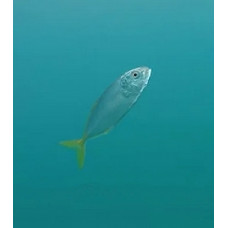Latin name
Alepes djedaba
Other name
Slender yellowtail kingfish
Identification
The body of the shrimp scad is elongated, compressed at the sides and covered with fine cycloid scales. The upper and lower body profiles are convex. The snout is pointed. The diameter of the eye is almost equal to the length of the snout. The fatty eyelid is well developed only in the posterior part of the eye. The upper jaw is slightly concave at the back. The maxilla is relatively large with a widening in the anterior part. The numerous teeth on both jaws are single-row, comb-shaped. There are small teeth on the scutellum, palate and tongue. The first gill arch has 38-47 gill stamens (including rudimentary stamens), with 10-14 stamens on the upper part and 27-33 stamens on the lower part. The margin of the sleithrum is smooth, without papillae. The lateral line forms a high arc in the anterior part and then continues straight to the caudal peduncle. The curved part of the lateral line has 31-36 scales and 0-3 bony flaps; the straight part has 0-2 scales and 39-51 bony flaps. Vertebrae: 10 trunk vertebrae and 14 tail vertebrae. The transition from the curved part of the lateral line to the straight part is on a vertical line passing through the area between the beginning of the second dorsal fin and the third soft ray. The length of the chord of the curved part is 2-2.6 times less than the length of the straight part.
Features of fish fins
The two dorsal fins are separated by a conspicuous gap. The first dorsal fin has 8 barb rays. The second dorsal fin has one barb and 18-20 soft rays. The barbed dorsal fin is large, with the longest barbed ray approximately equal to the length of the longest rays in the soft dorsal fin. The anal fin has 1 barb and 18-20 soft rays, with 2 barbs in front of the fin. The caudal fin is crescent-shaped.
Fish colouring
The body colour of the shrimp scad is greyish-green on the back, becoming silvery-white on the sides and belly. There is a distinct black spot on the edge of the gill cover, bordered by a smaller white spot above. The membranes between the dorsal rays are pale or dark. The dorsal fin blade is dark with a pale distal edge. The caudal fin is yellowish, except for the upper blade, which often has a dark or black edge. The rest of the fin is pale.
Distribution
Widespread in tropical and subtropical waters of the Indo-Pacific from the Red Sea and Persian Gulf along the east coast of Africa and along the Asian continent to western Australia; and off islands in the Indian Ocean. In the Pacific Ocean from southern Japan to north-eastern Australia; the Hawaiian Islands. Through the Suez Canal into the Mediterranean Sea.
Habitat
Pelagic marine fish. Inhabit coastal waters.
Size
Maximum length of these fish is 40 cm, usually up to 25 cm; body weight up to 124 g. Maximum reported weight: 603.00 g.
Behavior
Prawns form large schools.
Food and feeding habits
Feeds on crustaceans (shrimps, copepods, decapod larvae); large individuals may consume small fish. First mature at 17-19 cm body length. Spawns from December to September.
Reproduction
First mature at 17-19 cm body length. They spawn from December to September. Their eggs are pelagic.
Fishing
A commercially important species. Often caught by ski-boat anglers in South Africa.
Relationship with a person
Harmless.
| Classification | |
| Phylum | Chordata |
| Class | Actinopterygii |
| Squad | Carangiformes |
| Family | Carangidae |
| Genus | Alepes |
| Species | A. djedaba |
| Features | |
| Conservation status | Least Concern |
| Habitat | Pelagic |
| Life span, years | No information |
| Maximum body weight, kg | 0,603 |
| Maximum length, cm | 40 |
| Sailing speed, m/s | No information |
| Threat to people | Edible |
| Way of eating | Predator |
Shrimp scad
Tags: shrimp scad

